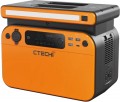Rated power
Power that a device can consistently produce for an indefinitely long time without any unpleasant consequences. For normal operation of the charging station, the rated power must be at least 15 - 20% higher than the total power of all devices simultaneously connected to it.
Peak power
Some electrical appliances (in particular, units with electric motors - refrigerators, air conditioners, etc.) consume significantly more energy at startup than after reaching the operating mode. For such a load, the peak power of the charging station must be taken into account - its indicator must be higher than the starting power of the load.
Sockets (230 V)
Total number of outlets with output voltage. This is, in fact, the number of devices that can be simultaneously connected to the charging station without the use of splitters, extension cords and carriers. Accordingly, weaker charging stations have
one or
two sockets in their submission.
Powerful charging stations already have three or
more sockets “on board”.
USB A
Full-size USB A connectors are popular in computer technology, they are standardly used in adapter chargers for 230 V household networks and 12 V auto sockets. In charging stations, such outlets are widely used for charging gadgets.
- The total number of such ports can be very diverse (
1 USB,
2 connectors,
3 ports and even
4), since it allows you to connect for charging, and in some cases for power, various low-power devices -
smartphones,
tablets,
power banks,
lamps, etc. .
- The strength of the power. The maximum power output through the USB A connector to the device being charged. Note that different ports of the charging station can output different power (for example, 1.5 A and 2.1 A). In this case, the highest power strength is usually indicated.
— Power. The maximum
output power in watts (W) that the charging station is capable of delivering through the USB A connector to one charging device.
USB C
USB type C ports are smaller than classic USBs, and they also have a convenient reversible design that allows you to connect the plug in either direction.
USB type C was originally designed to be able to implement various advanced features: increased power supply, fast charging technologies, etc.
Since the port is relatively new and quite powerful (there are
USB type C with a power of 60 W and even
100 W), the total number of such connectors is often limited to
1 port, less often
two).
- The strength of the power. The maximum power output through the USB type C connector to a charging device. Note that different ports of the charging station can output different power (for example, 1.5 A and 2.1 A). In this case, the highest power strength is usually indicated.
— Power. The maximum power in watts (W) that the charging station is capable of delivering to one rechargeable gadget. The high output power of the USB type C port allows you to speed up the charging process. However, the appropriate power must be supported by the device being charged - otherwise the speed of the process will be limited by the characteristics of the gadget.
Wireless charger
In wireless charging mode, energy is transferred to the gadget being charged through an inductive surface, which is usually built into the upper plane of the charging station case. There can be one slot for
wireless charging or several of them are provided. The range of this technology does not exceed a few centimeters. However, this method of charging eliminates the fuss with wires and reduces wear on the connectors. One of the key disadvantages of this format is considered to be low power and, accordingly, slow charging speed.
From solar panels
The ability to charge the device from solar panels ensures the energy independence of a portable power plant. Models with this function can work completely autonomously and do not depend on outlets.
Charging from the panels is implemented in the corresponding devices with portable solar panels and charging stations, which are structurally provided with specialized connectors for receiving power from stationary solar panels, and there is also a built-in MPPT charge controller (Maximum Power Point Tracking).
Via USB-C
The ability to replenish energy reserves in the battery cells of the charging station via
the USB type C connector. This port itself is small in size and has a convenient double-sided design, thanks to which the plug can be inserted in either direction. However, in charging stations it does not always work as an input interface.
DC input
DC connector for a distinctive round plug (like those used in many laptops) used to recharge the battery of the device. Note that
DC- in plugs may have different sizes, and chargers with such plugs may have different operating voltages. In practice, this leads to the fact that finding a suitable charger for a portable station is not easy, you need to be especially careful when searching.

